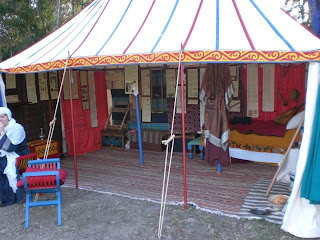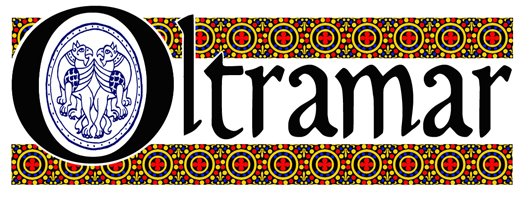 Abbey Museum Tournament. We arrived there late afternoon last Friday and set up the tent, the carpets, the hangings, the lamps... as it was getting dark by the time that was done I decided to leave setting up the actual display until the following morning, so we set up the camp beds for the girls and left it at that. Dad had the good sense to book a motel room for the weekend, so we had dinner with him in the restaurant attached to it (Sam had the biggest eye fillet steak I've ever seen!) and then returned to the festival site to do some socialising.
Abbey Museum Tournament. We arrived there late afternoon last Friday and set up the tent, the carpets, the hangings, the lamps... as it was getting dark by the time that was done I decided to leave setting up the actual display until the following morning, so we set up the camp beds for the girls and left it at that. Dad had the good sense to book a motel room for the weekend, so we had dinner with him in the restaurant attached to it (Sam had the biggest eye fillet steak I've ever seen!) and then returned to the festival site to do some socialising.I hadn't been to an Abbey tournament for about 5 years, and the difference in size was immediately apparent - this was going to be a HUGE event! The other thing I noticed was that there was a distinct lack of the bitterness and enmity between groups that used to plague the movement, and the general atmosphere was friendly and welcoming. We spent an hour or so wandering from campfire to campfire and chatting with folk - lovely to renew old acquaintances! - and then headed off to bed about 10ish...
Up early the next morning: into costume, setting up the display, grabbing pancakes for breakfast (the pancakes stall opened at 6.30am to feed the re-enactors, bless 'em!); Dad arrived a bit before 8 and helped set up and we were ready to go well before the public turned up an hour later.
We felt singularly honoured to lead the grand parade, as 'Brisbane's newest re-enactment group' (although it probably had more to do with the fact that I was scheduled to give a lecture on medieval textile production at 11 o'clock, shortly after the parade), and for the rest of the day had a steady stream of visitors to the tent, a lot of whom stayed quite a while, reading the display. I also ran a spinning class each day, which was nicely populated by about half a dozen people who seemed to get the hang of it and will probably turn out to be good spinners (with the ever-necessary bit of practice!).
We all took time out from 'tent-sitting' to have a wander around
 the fair, and the girls bought trinkets at the medieval market - stacks of stalls this year! - and had a good time. Dad was happy to watch the to-ing and fro-ing of the people - re-enactors and public - and answer odd questions about the display; the rest of us were more energetic and wandered around the place, but are paying for it today with sore feet and stiff legs - haven't done that much walking in ages!
the fair, and the girls bought trinkets at the medieval market - stacks of stalls this year! - and had a good time. Dad was happy to watch the to-ing and fro-ing of the people - re-enactors and public - and answer odd questions about the display; the rest of us were more energetic and wandered around the place, but are paying for it today with sore feet and stiff legs - haven't done that much walking in ages!Our little stall was a moderate success - didn't sell much of the medeival bits'n'pieces (wooden spoons, needlecases, odd bits of brass), but the cardweaving kits went very well - the kits are designed to teach the basics of cardweaving, and it seems people are interested in learning new skills, which is great!
I was very chuffed to receive so many compliments on the display -
 the nicest from Michael and Edith, who organise the Abbey Tournament and run the Abbey Museum; none of the other re-enactment groups displays in this way and I was trying something 'new' for the Brisbane re-enacment circle, so I'm glad (and very relieved) it was received so well. To explain: most groups set up a living history encampment, to show how people lived in the era they're re-enacting. They have tents, tables, campfires and such and they spend their time demonstrating skills of the period to the public: fighting, cooking, textiles, crafts, medicine... you name it. I've found, though, from doing this sort of re-enactment in the past, that the public are
the nicest from Michael and Edith, who organise the Abbey Tournament and run the Abbey Museum; none of the other re-enactment groups displays in this way and I was trying something 'new' for the Brisbane re-enacment circle, so I'm glad (and very relieved) it was received so well. To explain: most groups set up a living history encampment, to show how people lived in the era they're re-enacting. They have tents, tables, campfires and such and they spend their time demonstrating skills of the period to the public: fighting, cooking, textiles, crafts, medicine... you name it. I've found, though, from doing this sort of re-enactment in the past, that the public are  often unwilling to ask questions and will stand back and watch, and sometimes be puzzled about what's going on. My display, as you can see from the photos, is mainly textual with a lot of models about what the text is talking about. The display cover a variety of areas - Dad's Benedictines (the Public Service of the day providing education, medical care, record-keeping, and care of 'unfortunates'), textiles (including spinning, dyeing and weaving), clothing and cosmetics, food and utensils, games, music, medicine, and a smattering of other odd information. Where possible I include illustrations from the period, and models of whatever the display topic is talking about (a scale model upright loom, a medieval bed, crockery and so forth). The aim of this is to provide background knowledge of the period in easily-digestible, 18pt font chunks which will hopefully allow a greater appreciation of the living history seen in other encampments (some of the work that goes into these is incredible - hand-beaten pots, carved beds and tent-ends, beautiful costumes - an enormous amount of work!)
often unwilling to ask questions and will stand back and watch, and sometimes be puzzled about what's going on. My display, as you can see from the photos, is mainly textual with a lot of models about what the text is talking about. The display cover a variety of areas - Dad's Benedictines (the Public Service of the day providing education, medical care, record-keeping, and care of 'unfortunates'), textiles (including spinning, dyeing and weaving), clothing and cosmetics, food and utensils, games, music, medicine, and a smattering of other odd information. Where possible I include illustrations from the period, and models of whatever the display topic is talking about (a scale model upright loom, a medieval bed, crockery and so forth). The aim of this is to provide background knowledge of the period in easily-digestible, 18pt font chunks which will hopefully allow a greater appreciation of the living history seen in other encampments (some of the work that goes into these is incredible - hand-beaten pots, carved beds and tent-ends, beautiful costumes - an enormous amount of work!)All in all, it was an enjoyable and gratifying weekend - now we just have to wash and repack stuff for the next show, History Alive, in just under two weeks....

No comments:
Post a Comment